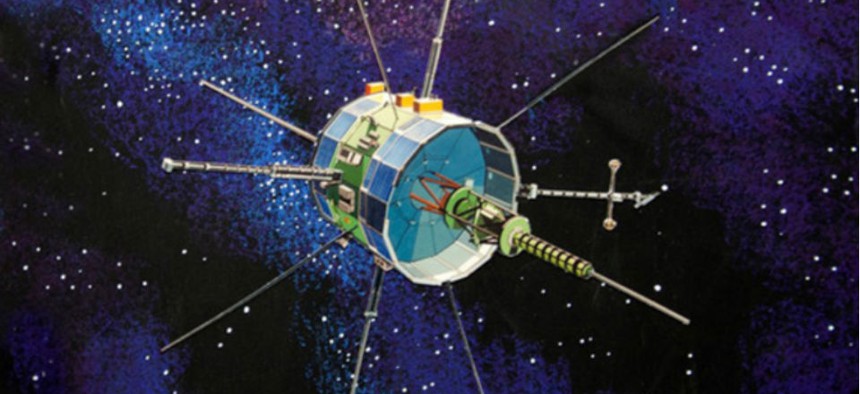NASA's Zombie Spacecraft Learns to Fire Its Engines

The ISEE-3 (ICE) spacecraft. NASA
As the presumed-dead probe hurtles toward Earth, the deadline for saving it looms.
The quest to save the ISEE-3—a long-lost NASA probe launched in the disco era and abandoned in the dot-com boom—might just succeed. Late last week, the amateur scientists and engineers working to salvage the probe hit a major milestone: They coaxed the craft into firing its rotational thrusters.
The achievement is important for many reasons. While the amateur team trying to reboot the ISEE-3 has been in radio contact with the probe for more than a month, this is the first time it has successfully commanded moving parts onboard. It’s important for technical reasons. The ISEE-3 is “spin-stabilized,” meaning it only functions properly when it’s tumbling over itself. The team can now adjust that spin.
And, finally, it’s important for planning reasons. Now, the team can begin to fire the ISEE-3’s thrusters and change the ship’s trajectory—hopefully, keeping it from crashing into the moon.
Keith Cowing, a journalist-turned-mission-leader, told me that they hoped to begin changing its course on Tuesday. “We’re pretty much confident now that it’ll come close to the moon but not crash into it,” he said.
Launched in 1978, the International Sun/Earth Explorer-3 first served for years as a solar observatory, sitting at a stable orbit point between the Earth and the Sun. By 1986, NASA had replaced the aging craft with superior sensors. They determined it didn’t need to occupy its stable position, so they piloted it through the tails of Comet Giacobini-Zinner and Halley’s Comet. The ISEE-3 was renamed ICE, the International Comet Explorer.
And then scientists decided they didn’t need it at all anymore. A NASA engineer directed the probe into a long, looping orbit, far around the sun, that would place it back in Earth’s vicinity around 2014.
That date has now arrived, but NASA won’t be the one monitoring ISEE-3. The agency abandoned the machinery needed to control and talk to the craft in 1997.
Instead, on August 10, 2014, the probe will pass just above the surface of the moon, and a group of amateurs led by Cowing and space engineer Dennis Wingo will be paying close attention. They put together the documentation, the engineering know-how, and the radio telemetry equipment needed to pilot the craft out of harm’s way.
The reboot mission had originally hoped to change the ISEE-3’s course weeks ago. When we first talked, Cowing told me that if they hadn’t begun firing its thrusters by July, he’d be nervous. But it turns out the probe wasn’t where it first seemed. “Initially, our calculations were based on old data, which showed the spacecraft not being where it was supposed to be,” Cowing said. “But we did a lot of ranging with NASA’s giant dishes—it’s a lot closer to where we thought it’d be.”
That means that they can expend less fuel putting it on a new trajectory, so the critical maneuver they've been planning can happen later. They'll have more time to change the probe's course without having to worry about the gravity of the Earth or moon pulling it onto their surfaces.
In the past month of working with the spacecraft, Cowing said they’d gotten used to its idiosyncrasies. ISEE-3 lacks an onboard computer, so commands must be fed to it one at a time. Cowing compared the process to rock-climbing: When it's time to move to the next outcrop, the movement has to happen quickly and definitively.
“You just have to push through it and the data you get back isn’t exactly what you want. As soon as it would take another command, you just rush through the next one and the next one,” he said.
“It’s like telling an old dot-matrix printer from back in the day to do something.”






